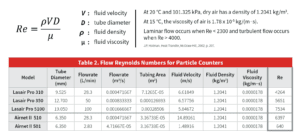Particle counters are used in many applications ranging from cleanroom and clean air device classification in accordance with specified standards, testing of filter installation, portable environmental monitoring programs, in-situ environmental monitoring systems and the fault diagnosis of specific processes. Historically, there has been a single volume flow rate of 1 CFM (28.3 LPM) chosen for many of these applications. However, particle loss in transport tubing can impact the accuracy of these measurements, making it crucial to consider flow rates and tubing lengths for reliable data.
Manufacturers of particle counters found that as regulations changed, higher volume flow rates were preferred for the classification of cleanrooms to either ISO14644-1(1) or EU GMP Annex 1(2) standards.
Particle Measuring Systems originally led the market with a true 100 LPM instrument, which enabled faster sampling of the cubic meter of air required for classification of a cleanroom either to ISO 4 or cleaner, or an EU GMP Grade A aseptic zone. The requirement for monitoring a process using a ‘standard’ 1 CFM device however, continues to prove the most suitable method of acquiring data at an ideal rate and with confidence that the process can be economically measured.
Particle Counter Types
Three instruments available from Particle Measuring Systems that satisfy all current needs of room classification and environmental monitoring programs are described in the table below.

As there are different types of instruments available, each with a different flow rate, a concern arises in the industry of what constitutes suitable transit of particles within tubing. Particle Measuring Systems has previously released information regarding the maximum suitable length of transport tubing(3) and this has been reinforced by the release of ISO 14644-1:2015 which advocates for shorter tubing lengths(1), World Health Organization requirements for vaccine manufacture which recommends that no more than 2.0 meters of tubing should be used(4), and the upcoming release of the updated EU GMP Annex 1, which discusses particle counter applications.
The next installment will discuss turbulence and how the Reynolds number can provide a basis for comparing tubing flow rates.
Want to read more? Jump to other released posts in this series: